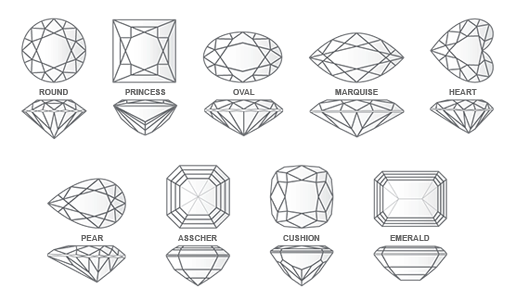Diamond Education
During your personal consultation, our trained staff will walk you through the diamond evaluation process and answer any questions you may have. Until then, here are some key things to know about what makes diamonds so unique.
To book an appointment, submit an inquiry or call us at (416) 861-8110. We look forward to helping you!
Ethically Sourced Diamonds
At Kimberfire, we care about both the quality and ethics of our diamonds. Like you, we care where our diamonds come from.
Every diamond we sell is guaranteed to be conflict free and our supply chain adheres strictly to the Kimberley Process, meaning that all our diamonds have been verified as coming from ethical sources. All of our receipts contain a written declaration that the diamonds purchased are guaranteed to be conflict free. This is our expectation of each and every one of our suppliers and is our commitment to you.
We also have access to a large selection of Canadian diamonds which have been mined in Canada and are accompanied by certificates of origin.
We’re always happy to discuss our supply chain with you and answer any questions you may have.
What’s in a Shape?
Diamonds are manufactured in a variety of shapes. The original and most classic of these is the round brilliant cut. Round brilliants also tend to be slightly more expensive than the other shapes, as approximately 50% of the rough diamond is lost during the process of cutting and polishing the stone.
Cuts other than round brilliant are known as “fancy” cuts. These cuts were developed as a way of salvaging a larger percentage of the rough diamond. As rough diamonds are found in a variety of dimensions, creating different shapes allows the diamond cutter to maximize the amount of material remaining in the polished stone. While there are many rare and unique fancy cuts, the most popular are princess, cushion, oval, emerald, asscher, pear, marquise and heart.

The Four C’s
All diamonds are evaluated using the “Four C’s” criteria: Cut, Clarity, Color and Carat.
Cut
Cut is a measure of the overall proportions and symmetry of a polished diamond. The goal is to minimize light loss and maximize the amount of light that enters the diamond and bounces back toward the eyes. This is where the brilliance or “sparkle” of the diamond comes from.
The cut of the diamond is graded as one of: Ideal / Excellent, Very Good, Good, Fair and Poor. We look for quality first, and select our diamonds for maximum fire and brilliance. To accomplish this, we only sell diamonds graded “Ideal”, “Excellent” or “Very Good” in cut. Anything below this does not meet our standards.
Clarity
As diamonds are created naturally, no two diamonds are alike. During the growth of the stone, impurities and blemishes naturally develop. These inclusions appear in different sizes, colors and shapes and in different locations of the diamond. All of these criteria contribute to the clarity grade of a diamond.
We carefully select only the nicest and brightest diamonds of each clarity grade. No visible black spots or hazy material. We also make sure that all our diamonds are 100% clean of inclusions to the naked eye, ensuring you can stare at your diamond for eternity, and never second-guess your selection.
GIA sets the following clarity grades:
- IF (Internally Flawless) – no inclusions can be seen, even under a microscope at 50x magnification.
- VVS1/VVS2 (Very Very Slightly Included) – inclusions can only be seen under a microscope at 50x magnification.
- VS1/VS2 (Very Slightly Included) – inclusions can be with a loupe at 10x magnification, and only on very close and diligent inspection.
- SI1/SI2 (Slightly Included) – inclusions can be easily seen with a loupe at 10x magnification.
- I1/I2/I3 (Included) – inclusions can be easily seen with the naked eye, without any magnification.
So how to choose? In order to select diamonds that are brilliant and “eye clean”, our preferred clarity grades range from a VS2 diamond to a very strictly graded and inspected SI2. This allows us to maximize the size of the diamonds we can provide while not sacrificing their visual appeal and brilliance in the slightest.
For all diamonds, no matter the clarity grade, it is important to inspect your selection in person prior to making any decision. Wouldn’t you want to see your diamond before taking it home?
Color
White diamonds are graded on a scale from the whitest color D, down to the extremely yellow-tinted Z. D/E/F diamonds are known as “colorless” and are extremely rare; G is considered a “rare-white”; and H is considered “baseline white”. Side-by-side, it is very difficult to tell the difference between adjacent color grades, and the difference between diamonds that are two-color grades apart will hardly be noticeable once the diamond is set.
To maximize value, while maintaining a colorless look, our preferred colors are F to I. D and E colored diamonds can be significantly more expensive without offering much benefit. On the other hand, H colored diamonds are guaranteed to be very bright and white.

Carat
Carat is the term used for the weight of a diamond. The size of a diamond is up to both your budget and personal preference. At Kimberfire, we try to maximize the size of the diamond you can purchase within your budget, without going below our quality standards on the other three of the four C’s.

To book an appointment, submit an inquiry or call us at (416) 861-8110. We look forward to helping you!



